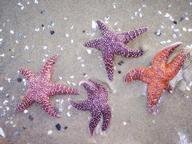Quiz Answer Key and Fun Facts
1. Don't let the appearance of this starfish fool you. It is the real thing. What is the comfortable name of this common starfish?
2. The sunflower sea star starts out with how many arms?
3. This beautiful red knobbed starfish is usually found in which body of water, known as the warmest of the earth's oceans?
4. In which of the following locations would you most likely find a Brisingida sea star?
5. Where are the eyes of a starfish located?
6. All starfish are filter feeders whose primary food source is plankton.
7. Which of the following things do all starfish have?
8. All starfish belong to the phylum of Echinodermata.
9. Starfish move by using hundreds of tubular feet found on their underside.
10. Why should you never pick up a crown-of-thorns starfish if you find it on the beach?
Source: Author
dcpddc478
This quiz was reviewed by FunTrivia editor
Tizzabelle before going online.
Any errors found in FunTrivia content are routinely corrected through our feedback system.

